The Toyota Camry was never really a jack of all trades. It was safe, reliable, efficient, and inexpensive, but it was never "fun to drive," despite a few TRD-powered exceptions. The 2025 Toyota Camry still isn't a sports sedan, but now its appliance-like productivity is matched by its credible on-road performance. Powertrains have been winnowed down to one, a fuel-sipping but powerful hybrid, and any model (including the least expensive LE model, which is $455 cheaper than last year) can now be equipped with all-wheel drive.
Read more: Compare the Top Car Warranty Companies
Toyota, a company that looks smarter by the day as many automakers pivot back to hybrids, uses the fifth generation of its Toyota Hybrid System on the 2025 Camry to deliver a nearly unheard of in the midsize segment 51 miles per gallon combined. That's with a 2.5-liter four-cylinder engine with two electric motors now delivering 225 horsepower (hp) combined on front-wheel drive models and 232 hp with its Electronic On-Demand All-Wheel Drive system and a third motor on the rear axle.
That rear motor comes online when additional traction is needed in slippery or snowy conditions, but also activates when accelerating from a stop and accelerating around a corner for better weight balance and more stable handling.
As before the 2025 Camry starts with the LE trim followed by the SE, and then splits off to the sportier XSE and more comfort focused XLE trims. The base model is $28,400, followed by the SE at $30,700. The XSE is $34,600; all-wheel drive adds $1,525 to any trim.
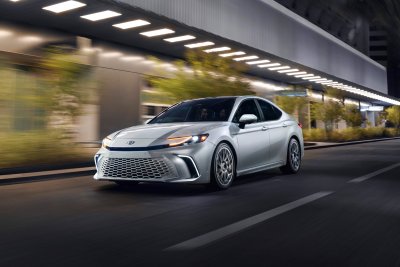
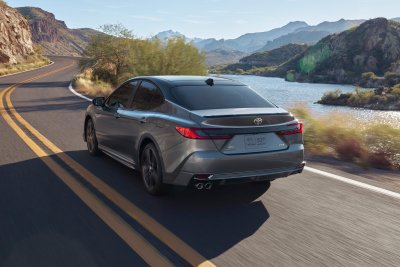
To differentiate the sporty SE and XSE models Toyota adds a sport-mesh front grilles, side sport rockers, functional front side air ducts, a rear spoiler and rear diffuser with an exposed dual-tip exhaust. They also feature a gloss back Camry badge. All have the "hammerhead" look pioneered on the latest Toyota Prius.
The SE and XSE aren't just visual upgrades as they come with a specific sport-tuned suspension differing from the LE and XLE models with new shock absorbers and a larger diameter front stabilizer bar. There's also a new braking system that uses on-demand pressurization meaning the pedal doesn't sink to the floor whether the brakes are slammed on or gently nudged. The sportiness of the powertrain, though not the braking or steering, can be adjusted via Normal, Eco and Sport drive modes.
The Toyota Camry still isn't a canyon-carving sports car, but the combination of more accurate steering, better-but-not-perfect brakes and a more powerful powertrain makes it feel like driving dynamics were a concern for the engineers, something that's rarely come through on the Camrys of the past.
The steering is still lightly weighted, but the four-door sedan is entertaining to drive on empty winding roads, more so in Sport mode when the revolutions per minute (rpm) stay high and more acceleration is on tap. Still, with the continuously variable automatic transmission there's always a delay (when cruising) between pressing the pedal and gaining a lot of speed.
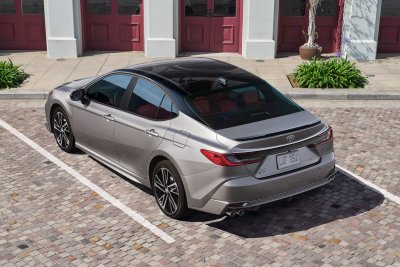
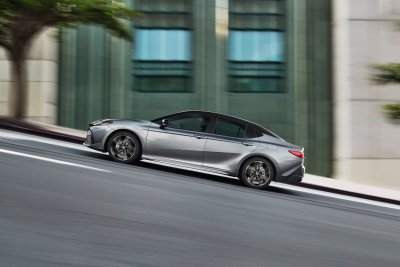
Moving inside, the LE will feature an interior inspired by ocean waves, according Toyota, with an embossed pattern in the fabric. The higher-end XLE trim features a combination of leather and Dinamica microfiber-trim in either gray or black. Whatever the pattern or material, it continues onto the door panels for a complete look.
The SE has black or brown SofTex-trimmed seats with white accents while the XSE adds leather trim with a pattern that again runs onto the doors. The more expensive model is available in two interior colors including black with blue-lined perforations or the fan-favorite red. Both the SE and XSE also come with aluminum sport pedals and a leather-wrapped steering wheel. with paddle shifters and a leather-wrapped shift knob.
Heated front seats are standard on the XLE and XSE and are optional on the LE and SE grades. The higher-end trims are also offered with ventilated seats and a standard heated steering wheel. All Camrys come with push button start and dual-zone automatic climate control.
As for technology, a 7-inch digital gauge cluster comes standard on LE and SE models, while XLE and XSE trims get a 12.3-inch digital gauge cluster. The XLE and XSE are also offered with a 10-inch head-up display.
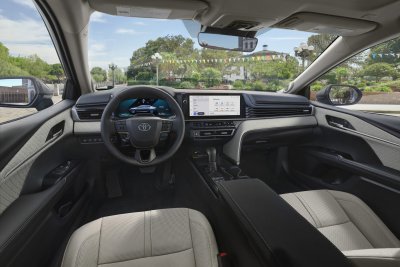
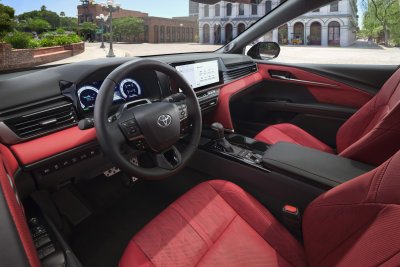
An 8-inch touchscreen infotainment system is standard, and a 12.3-inch screen is available. All include wireless Apple CarPlay and Android Auto and wireless charging. The Camry has five USB ports, with three in the front (2 USB-c and 1 USB-a) and two in the rear (1 USB-c and 1 USB-c). It all worked perfectly during our test drive, connecting with an iPhone quickly and easily. The steering wheel buttons make it easy to swap songs without taking hands off the wheel.
Toyota changed the shape of the Camry's seats with a longer cushion length and they are, like Lexus, expectedly soft and comfortable, while also holding the driver in place. They're not narrow, and not set low, but surprisingly supportive, which makes entrances and exits easy.
The back seat feels huge with a 5-foot, 10-inch adult in front, leaving many inches of kneeroom to spare. Width-wise it looks like plenty of space for two child seats and a passenger in the middle and the trunk is also family-sized for four persons worth of gear or luggage.
The 2025 Toyota Camry continues with a large suite of safety features including emergency braking for vehicles and pedestrians, adaptive cruise control, lane departure alert and steering assist, lane tracing to keep the vehicle between the lines and road sign assist.
The new Proactive Driving Assist uses the vehicle's camera and radar to brake and steer as necessary while driving. It's a hands-on-wheel system, unlike Super Cruise, but it does take some of the stress out of longer commutes on easy, well-marked highways.
The Toyota Camry ($28,400 for the base LE trim) will deal with competition from the restyled Honda Accord ($27,895) and the new Nissan Altima ($25,730), though both of those sedans are far behind in sales. And that makes sense. The Camry has only improved in the last 20 years from its original place as "excellent and affordable transportation" to something with style and character and even a bit of flash (there are three grille options depending on trim).
Read more: How to Shop for an Extended Car Warranty
However, all three use continuously variable transmissions, which aren't suited to sporty driving. The Honda is still the best handler of the bunch; the Altima offers the most power, but the Camry excels in everything else. It is the most expensive of the three, but still extremely affordable in world with an average transaction price approaching $50,000. The Toyota Camry won't reverse the trend of SUVs overtaking sedans, but it will stem the tide.
Uncommon Knowledge
Newsweek is committed to challenging conventional wisdom and finding connections in the search for common ground.
Newsweek is committed to challenging conventional wisdom and finding connections in the search for common ground.
About the writer
Jake Lingeman is the Managing Editor for the Autos team at Newsweek. He has previously worked for Autoweek, The Detroit ... Read more
To read how Newsweek uses AI as a newsroom tool, Click here.








